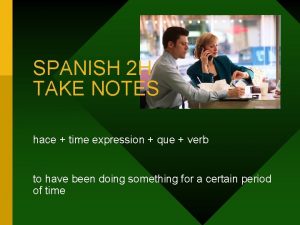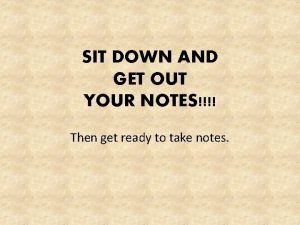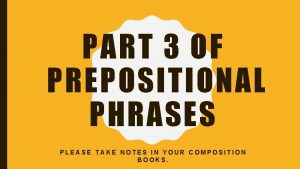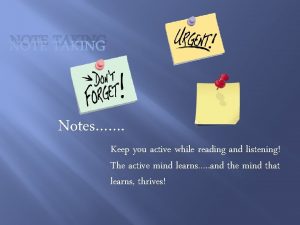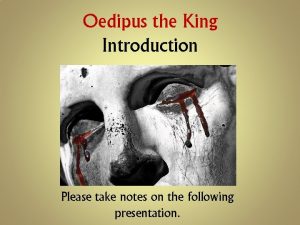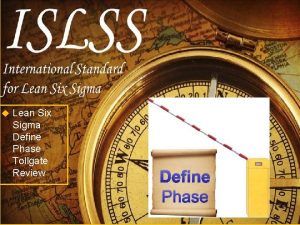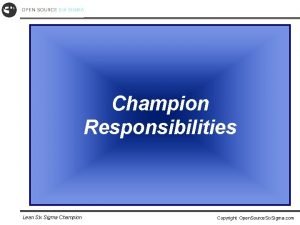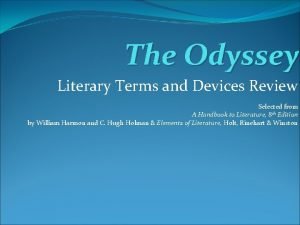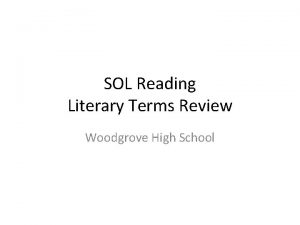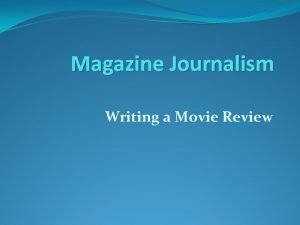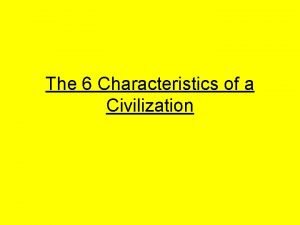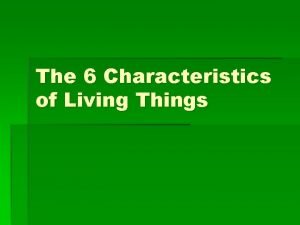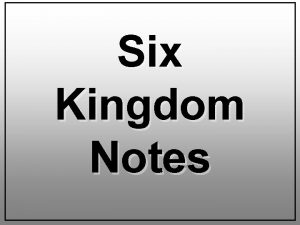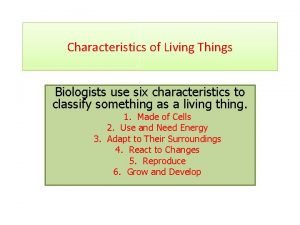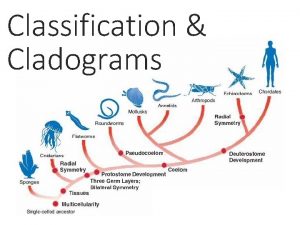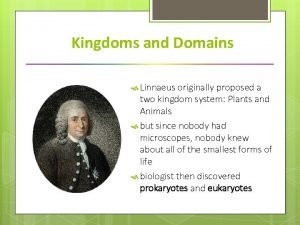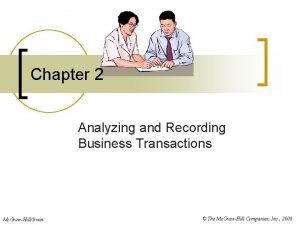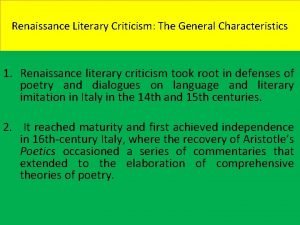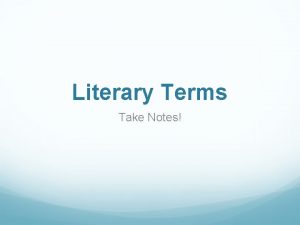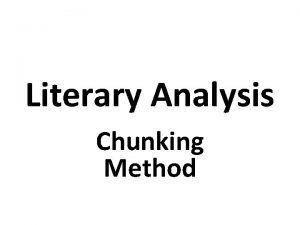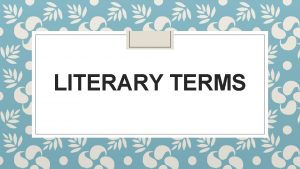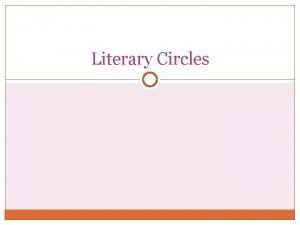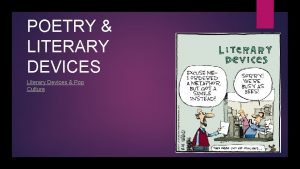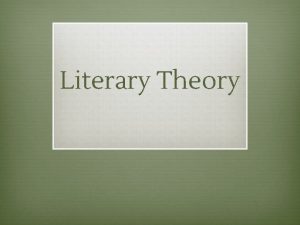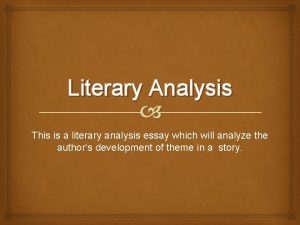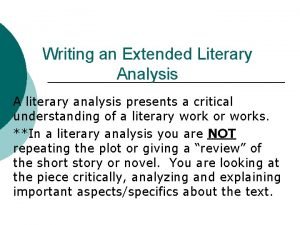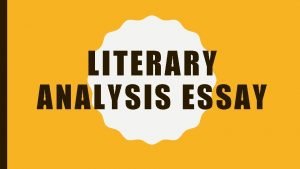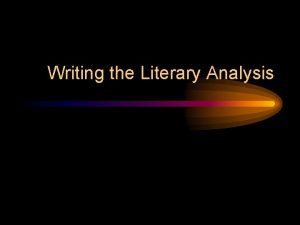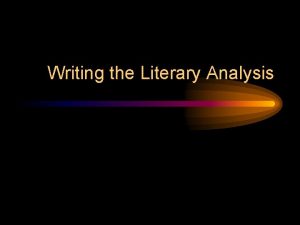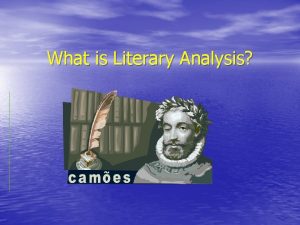Six Characteristics of Literary Analysis Review Take Notes




































- Slides: 36

Six Characteristics of Literary Analysis Review – Take Notes!

What is characterization?

What is characterization? It is HOW an author reveals a character.

What is Indirect Characterization?

What is Indirect Characterization? It is how we learn about a character through speech, appearance, actions, thoughts, what other characters think.

What is Direct Characterization?

What is Direct Characterization? When an author tells us about a character.

What is the characteristic that explains an author’s word choice?

What is the characteristic that explains an author’s word choice? DICTION!

Diction… Good writers do not use words like pretty, nice, and bad. Instead, they use words that invoke a specific effect A coat isn’t torn; it is tattered. The U. S. Army does not want revenge; it is thirsty for revenge. A door does not shut; it thuds.

More Diction… Diction depends on topic, purpose, and occasion. Formal diction is largely reserved for scholarly writing and serious prose or poetry. Informal diction is the norm in expository essays, newspaper editorials, and works of fiction.

More Diction… When studying diction, students must understand both connotation (the meaning suggested by the word) and denotation (the word’s literal meaning). When a writer calls a character slender, the word evokes a different feeling from calling the character gaunt. A word’s power to produce a strong reaction in the reader lies mainly in its connotative meaning.

Practice Diction A Explain the differences in connotation among the members of each of the following groups of words: Hurl, throw, pitch, chuck, toss, fling, cast

Practice Diction B Explain the differences in connotation among the members of each of the following groups of words: Bizarre, singular, far out, outlandish, off the wall, curious, odd, unusual, extraordinary, remarkable, noteworthy, strange, eerie

Practice Diction C Explain the differences in connotation among the members of each of the following groups of words: Mansion, dwelling, residence, house, home, habitat

What is it called when we have an expression that needs our imagination to figure it out?

What is it called when we have an expression that needs our imagination to figure it out? Figurative Language!

A simile is an example of figurative language… As big as a house! As hungry as a horse! Her hair was like gravy, running brown off her head and clumping up on her shoulders.

A metaphor is an example of figurative language…

A heart of stone You are the light in my life It is raining cats and dogs

Personification is an example of figurative language… The angry clouds marched across the sky. The tired school bus spit out the students. The evening stars winked at me from the sky.

What is tone?

What is tone? The attitude a writer takes.

More Tone… For example, textbooks are usually written with an objective tone which includes facts and reasonable explanations. The objective tone is matter-of-fact and neutral. The details are mostly facts. On the other hand, fiction and personal essays are usually written with a subjective tone. A subjective tone uses words that describe feelings, judgments, or opinions. The details are likely to include experiences, senses, feelings, and thoughts.

Tone Example A This place does need some repairs, but I’m sure the landlord will be making improvements sometime soon. The tone is optimistic. The writer is expecting the apartment to be improved soon.

Tone Example B When we move away, we’re planning to release three hundred cockroaches and tow mice, so we can leave the place exactly as we found it. The tone is humorous. The writer claims to be planning a comic revenge on the landlord by returning the apartment to the terrible condition it was in when the tenants moved in.

Tone Example C This is the apartment we live in. It provides shelter. The tone is objective. The writer does not express feelings about the apartment. He simply states facts.

What is theme?

What is theme? It is the author’s message.

The way in which an author chooses to write is called …?

The way in which an author chooses to write is called …? Style!

Style… • Many different elements go into what makes up an author's "style": • Word choice (also called "diction"): Does the author use words drawn from everyday language and slang, or from a higher vocabulary level? • Length and complexity of sentences: Are story sentences short and choppy, or long and complex?

Style… • Punctuation: Does the author use punctuation in any distinctive ways that differ from normal usage? • Use of imagery and symbols: Does the author make use of special images or symbols to tell the story?

Style… • Sound and rhythm: Does the author choose or arrange words for the way they sound? How does the story sound when you read it aloud? • Format: Does the author use standard prose and paragraphing? Does the author write in a sequential order, or does she skip around?

Look over your notes!

Resources http: //www. irsc. edu/uploaded. Files/Students /Academic. Support. Center/Writing. Lab/Ton e-and-Purpose. pdf http: //sharepoint. mvla. net/teachers/Steven K/Language%20 and%20 Comp%20 AP/Do cuments/AP_Exam_Preparation/Diction. pd f
 Take a bus or take a train
Take a bus or take a train To take notes in spanish
To take notes in spanish Sit down and take notes
Sit down and take notes Take prepositional phrase
Take prepositional phrase Active note taking
Active note taking Oedipus the king introduction
Oedipus the king introduction A polygon with six congruent sides and six congruent angles
A polygon with six congruent sides and six congruent angles Facteur g
Facteur g Define tollgate
Define tollgate Open source six sigma review
Open source six sigma review Literary elements
Literary elements Literary devices in the odyssey
Literary devices in the odyssey Iambic pentameter example
Iambic pentameter example Literary elements review
Literary elements review Literary devices review
Literary devices review Movie review informative journalistic literary
Movie review informative journalistic literary Literary terms review game
Literary terms review game Literary elements and techniques
Literary elements and techniques Literary devices allusion
Literary devices allusion Chapter review motion part a vocabulary review answer key
Chapter review motion part a vocabulary review answer key Ap gov final review
Ap gov final review Narrative review vs systematic review
Narrative review vs systematic review Example of inclusion and exclusion criteria
Example of inclusion and exclusion criteria Narrative review vs systematic review
Narrative review vs systematic review What is characteristics of civilization
What is characteristics of civilization 6 characteristics of living things
6 characteristics of living things Protista characteristics chart
Protista characteristics chart Six characteristics of living things
Six characteristics of living things The six characteristics of life
The six characteristics of life Cladogram kingdoms
Cladogram kingdoms Common characteristics of the six kingdoms of life
Common characteristics of the six kingdoms of life Characteristics of the six kingdoms
Characteristics of the six kingdoms Measurement cheat sheet
Measurement cheat sheet Six steps of business transaction analysis
Six steps of business transaction analysis The six step blueprint for process analysis begins with:
The six step blueprint for process analysis begins with: Six sigma at academic medical hospital case analysis
Six sigma at academic medical hospital case analysis What is the characteristics of literary theory
What is the characteristics of literary theory

